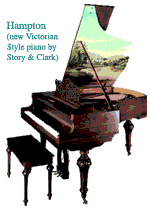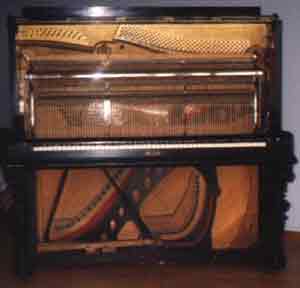PIANO PLAYING HISTORY
 The earliest "pianos" were designed in the tradition
of harpsichords and clavichords. Thus the technique of playing,
the literature, and even the tone was in the style of the parent
instruments. In 1732, Lodovico Biustini published "Sonate
da Cimbalo di Piano e Forte". This collection includes 12
sonatas with dynamic markings implying crescendos and descrescendos,
the first work written specifically for the piano. However, no
other works especially for the piano are known until 1770 when
Muzio Clementi wrote his 3 Sonatas, Opus 2. From that time, the
piano was sufficiently distinct to inspire a new type of playing
and a new kind of literature.
The earliest "pianos" were designed in the tradition
of harpsichords and clavichords. Thus the technique of playing,
the literature, and even the tone was in the style of the parent
instruments. In 1732, Lodovico Biustini published "Sonate
da Cimbalo di Piano e Forte". This collection includes 12
sonatas with dynamic markings implying crescendos and descrescendos,
the first work written specifically for the piano. However, no
other works especially for the piano are known until 1770 when
Muzio Clementi wrote his 3 Sonatas, Opus 2. From that time, the
piano was sufficiently distinct to inspire a new type of playing
and a new kind of literature.
Keyboard players
had to learn new techniques, Versuch quotes C. P. E. Bach as saying
"the more recent pianoforte, when it is sturdy and well built,
has many fine qualities, although its touch must be carefully
worked out , a task which is not without its difficulties"
(Davies, 1980).
 By the end of the 18th Century, the piano was reliable and
powerful enough to inspire composers like Mozart and Beethoven
to do special works for the piano. They could even feature the
piano as a solo instrument with a symphony orchestra. In the early
1800s there was a big difference in touch and timbre between the
English and Viennese pianos. Beethoven was impressed by the robust
bass and clear middle register of his 1817 Broadwood. Brahms and
Haydn preferred the delicate touch and crisp tone of the Viennese.
Chopin preferred the suavity of the French pianos of Pleyel.
By the end of the 18th Century, the piano was reliable and
powerful enough to inspire composers like Mozart and Beethoven
to do special works for the piano. They could even feature the
piano as a solo instrument with a symphony orchestra. In the early
1800s there was a big difference in touch and timbre between the
English and Viennese pianos. Beethoven was impressed by the robust
bass and clear middle register of his 1817 Broadwood. Brahms and
Haydn preferred the delicate touch and crisp tone of the Viennese.
Chopin preferred the suavity of the French pianos of Pleyel.
Every type of piano was distinct and served its purpose. People
often ask today which is the "best piano". History tells
us that it depends upon which type of music you are playing. The
pianos of the early 19th Century did have a common positive factor.
They were louder, more expressive and responsive to the touch
than any other instrument of the era. Versatility in expression
made the piano the ultimate Romantic Era instrument.
 Until Steinway introduced sturdier, more reliable instruments
after 1860, strings and hammers sometimes did not survive a vigorous
concert. Before then, tuners and spare pianos had to be on hand
for every concert. Durability made Steinway the standard for grand
piano manufacture worldwide.
Until Steinway introduced sturdier, more reliable instruments
after 1860, strings and hammers sometimes did not survive a vigorous
concert. Before then, tuners and spare pianos had to be on hand
for every concert. Durability made Steinway the standard for grand
piano manufacture worldwide.
 The second half of the 19th Century
also saw the rise of the specialist In teaching. Men like Czerny
(Listz's teacher) and Theodor Leschetzky (with students like Paderewski,
Friedman, Horzszowski, and many others who achieved international
fame), taught but rarely, if ever, played in public. Method books
analyzing the physical aspects of piano playing became more common
after 1900 with such pedagogists as Tobias Matthay, James Ching,
Otto Ortmann, Josef Cat, etc.
The second half of the 19th Century
also saw the rise of the specialist In teaching. Men like Czerny
(Listz's teacher) and Theodor Leschetzky (with students like Paderewski,
Friedman, Horzszowski, and many others who achieved international
fame), taught but rarely, if ever, played in public. Method books
analyzing the physical aspects of piano playing became more common
after 1900 with such pedagogists as Tobias Matthay, James Ching,
Otto Ortmann, Josef Cat, etc.
Some 20th Century compositions require players to use new and
complex techniques such as half or quarter pedaling, prepared
piano (devises inserted in the strings to change the tone), and
various methods of producing tones by reaching inside or underneath
the piano to pluck or strike the strings or other parts of the
piano. Piano playing technique has changed through the years with
changes in piano types and musical styles. Factors of touch, fingering,
phrasing and interpretation should be appropriately adjusted when
playing music of the 18th and 19th Centuries on the modern piano.
Piano playing in Nazi Europe saved her life. Zhanna Arshanskaya Dawson took but one possession when the Nazis forced her family from their home - the sheet music of her favorite piece, Chopin’s Fantasy Impromptu. She kept it safe throughout the war and treasures it to this day. It is the music you hear on this page. The pieces you will hear on the website are from the classical repertoire Zhanna played for the Nazis.
 The earliest "pianos" were designed in the tradition
of harpsichords and clavichords. Thus the technique of playing,
the literature, and even the tone was in the style of the parent
instruments. In 1732, Lodovico Biustini published "Sonate
da Cimbalo di Piano e Forte". This collection includes 12
sonatas with dynamic markings implying crescendos and descrescendos,
the first work written specifically for the piano. However, no
other works especially for the piano are known until 1770 when
Muzio Clementi wrote his 3 Sonatas, Opus 2. From that time, the
piano was sufficiently distinct to inspire a new type of playing
and a new kind of literature.
The earliest "pianos" were designed in the tradition
of harpsichords and clavichords. Thus the technique of playing,
the literature, and even the tone was in the style of the parent
instruments. In 1732, Lodovico Biustini published "Sonate
da Cimbalo di Piano e Forte". This collection includes 12
sonatas with dynamic markings implying crescendos and descrescendos,
the first work written specifically for the piano. However, no
other works especially for the piano are known until 1770 when
Muzio Clementi wrote his 3 Sonatas, Opus 2. From that time, the
piano was sufficiently distinct to inspire a new type of playing
and a new kind of literature. By the end of the 18th Century, the piano was reliable and
powerful enough to inspire composers like Mozart and Beethoven
to do special works for the piano. They could even feature the
piano as a solo instrument with a symphony orchestra. In the early
1800s there was a big difference in touch and timbre between the
English and Viennese pianos. Beethoven was impressed by the robust
bass and clear middle register of his 1817 Broadwood. Brahms and
Haydn preferred the delicate touch and crisp tone of the Viennese.
Chopin preferred the suavity of the French pianos of Pleyel.
By the end of the 18th Century, the piano was reliable and
powerful enough to inspire composers like Mozart and Beethoven
to do special works for the piano. They could even feature the
piano as a solo instrument with a symphony orchestra. In the early
1800s there was a big difference in touch and timbre between the
English and Viennese pianos. Beethoven was impressed by the robust
bass and clear middle register of his 1817 Broadwood. Brahms and
Haydn preferred the delicate touch and crisp tone of the Viennese.
Chopin preferred the suavity of the French pianos of Pleyel. Until Steinway introduced sturdier, more reliable instruments
after 1860, strings and hammers sometimes did not survive a vigorous
concert. Before then, tuners and spare pianos had to be on hand
for every concert. Durability made Steinway the standard for grand
piano manufacture worldwide.
Until Steinway introduced sturdier, more reliable instruments
after 1860, strings and hammers sometimes did not survive a vigorous
concert. Before then, tuners and spare pianos had to be on hand
for every concert. Durability made Steinway the standard for grand
piano manufacture worldwide. The second half of the 19th Century
also saw the rise of the specialist In teaching. Men like Czerny
(Listz's teacher) and Theodor Leschetzky (with students like Paderewski,
Friedman, Horzszowski, and many others who achieved international
fame), taught but rarely, if ever, played in public. Method books
analyzing the physical aspects of piano playing became more common
after 1900 with such pedagogists as Tobias Matthay, James Ching,
Otto Ortmann, Josef Cat, etc.
The second half of the 19th Century
also saw the rise of the specialist In teaching. Men like Czerny
(Listz's teacher) and Theodor Leschetzky (with students like Paderewski,
Friedman, Horzszowski, and many others who achieved international
fame), taught but rarely, if ever, played in public. Method books
analyzing the physical aspects of piano playing became more common
after 1900 with such pedagogists as Tobias Matthay, James Ching,
Otto Ortmann, Josef Cat, etc.